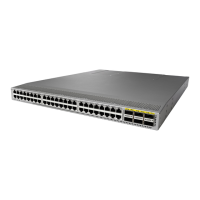Send document comments to nexus3k-docfeedback@cisco.com
9-10
Cisco Nexus 3000 Series NX-OS Unicast Routing Configuration Guide, NX-OS Release 5.0(3)U1(1)
Chapter 9 Configuring Layer 3 Virtualization
Configuring VRFs
This example shows how to create a VRF and add an interface to the VRF:
switch# configure terminal
switch(config)# vrf context RemoteOfficeVRF
switch(config-vrf)# exit
switch(config)# router ospf 201
switch(config-router)# vrf RemoteOfficeVRF
switch(config-router-vrf)# maximum-paths 4
switch(config-router-vrf)# interface ethernet 1/2
switch(config-if)# vrf member RemoteOfficeVRF
switch(config-if)# ip address 192.0.2.1/16
switch(config-if)# ip router ospf 201 area 0
switch(config-if)# exit
switch(config)# copy running-config startup-config
Configuring a VRF-Aware Service
You can configure a VRF-aware service for reachability and filtering. See the “VRF-Aware Services”
section on page 9-3 for links to the appropriate chapter or configuration guide for information on how
to configure the service for VRFs. This section uses SNMP and IP domain lists as example services for
the detailed configuration steps.
Step 4
maximum-paths
paths
Example:
switch(config-router-vrf)# maximum-paths
4
(Optional) Configures the maximum number of equal
OSPFv2 paths to a destination in the route table for this
VRF. Used for load balancing.
Step 5
interface
interface-type slot/port
Example:
switch(config)# interface ethernet 1/2
switch(config-if)#
Enters interface configuration mode.
Step 6
vrf member
vrf-name
Example:
switch(config-if)# vrf member
RemoteOfficeVRF
Adds this interface to a VRF.
Step 7
ip address
ip-prefix/length
Example:
switch(config-if)# ip address
192.0.2.1/16
Configures an IP address for this interface. You must
do this step after you assign this interface to a VRF.
Step 8
ip router ospf
instance-tag
area
area-id
Example:
switch(config-if)# ip router ospf 201
area 0
Assigns this interface to the OSPFv2 instance and area
configured.
Step 9
copy running-config startup-config
Example:
switch(config)# copy running-config
startup-config
(Optional) Saves this configuration change.
Command Purpose

